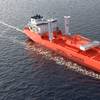While shipboard noise is an obvious concern to personnel operating or luxuriating onboard, increasing attention is being paid to the effects of ship-generated noise on the ocean environment. Consequently, this should catch the attention of ship designers, builders, owners and outfitters as the topic inevitably starts making the conference and legislative rounds.
Headlining efforts in the U.S. is the National Resources Defense Council (NRDC), whose researchers are studying the effects of man-made undersea noise and its relationship to a healthy ocean, and its effects on certain types of marine species.
Undersea noise has reportedly been shown as affecting the habitual behavior of marine mammals; leading them to swim off course, abandon traditional breeding grounds, and cease from singing, clicking, and performing the patterned sequences of sound, experts believe, they use for communication in the depths of the ocean.
"The amount of noise in our oceans nearly doubles every 10 years," says Roger Jentry the coordinator for the National Marine Fisheries Service (NMFS) Acoustics Team. According to a recent report put out the NRDC, the largest producer of undersea noise is shipping. NRDC statistics reveal that since the on-set of the global economy the size of the merchant fleet has doubled and gross tonnage quadrupled engrossing shipping lanes and the ocean's lower frequencies with constant noise. The same lower frequencies existing research has shown marine species use to interact in. "Ironically shipping is the No. I source of noise pollution and it is the least regulated," says Joel Reynolds, NRDC's Project Director.
In 1996, two sperm-n whales swimming nearby Spain's Canary Islands were struck from behind and killed by a cargo ship. Investigations believe that neither one made any attempt to escape the ship's path. Reports say, both whales were suffering from low-frequency acoustic trauma in the inner ear and apparently did not hear the ship approaching.
Researchers have shown that a supertanker cruising at 17 knots fills the frequency band below 50OHz, with a steady sonic sound, says the NRDC report, of 190 decibels or more, and mid-sized vessels such as tugs and ferries can produce sounds of 160-170 decibels.
One of the most infamous examples of the dangers high decibels of sound in the lower frequencies of the ocean can have on marine life occurred in 1996, and notably does not involve commercial shipping at all. During 1996 12 Cuvier beaked whales beached themselves off the West Coast of Greece. Investigators said, each whale was spaced about two miles apart from each other on shore and all were said to have fled the waters in a sudden panic at about the same time. This came just days after NATO had been experimenting with a low-frequency active sonar (LFAS) in the area.
LFAS is an experiment deployed by the U.S. Navy as early as the mid-1980's to detect diesel and nuclear submarines. Reynolds says the main concern with LFAS is the extraordinarily loud ranges of sound that are sent out into the lower frequencies of the ocean in areas of rich biological resources. Sometimes these sounds have been known to be as high as 235 decibels or greater, much stronger than the level of 120 decibels in which gray whales have shown to be disturbed.
"I'm realistic enough to know things don't change overnight," says Reynolds, calling for workshops to begin to discuss the types of regulations that can be feasible. To date there are apparently no regulations on the matter, so NRDC has been using the Marine Mammal Protection Act (MMPA) on an ad-hoc basis to legally battle the Navy and other sources who they believe are putting species at risk with little justification for their needs.
Reynolds says undersea noise can be regulated in much the same way other forms of pollution have been in the past, taking its cue from the Clean Air and Clean Water Acts. "It will take some time, but it must be done," he says.
Momentarily the deployment of LFAS has been stopped pending further research, but other forms of noise continue. The offshore industry, for one, is sure to come under closer scrutiny for noise production, with its seismic surveys, airguns, the positioning of drills, the construction of platforms and pipes. According to the NRDC report, marine mammals encountering these production sites either avoid the airguns, swerve off course, as bowhead whales do, or completely evacuate the area, as sperm whales exhibited during a seismic survey.
Within the last decade there has also been another contributing source: thermal acoustic thermometry. In the hopes of providing evidence of the greenhouse effect and global warming, scientists began experimenting with acoustic then-thermometry. The goal: to calculate the average ocean temperatures by the amount of time sound takes to travel undersea, using the knowledge that speed of sound increases as water warms. What organizations like the NRDC are most concerned with however, is the amount of time the experiment would take to conclude, estimating that as many as 12 transoceanic loudspeakers would be emitting 195-decibels of low-frequency tones throughout the ocean for as long as a decade.
"Undersea noise is really an unknown form of pollution," says Jentry. One of the first things that must be done, he says, is to begin discussing and writing clearer guidelines on acoustics that incorporates all the elements of man-made noise. To date, there isn't enough research on the hearing ranges of the numerous species of our oceans; we need to adequately define harassment for marine life, says Jentry. -- Maria Medina
Sponsored Content
Lower carbon intensity fuels to support your operations

Subscribe for
Maritime Reporter E-News
Maritime Reporter E-News is the maritime industry's largest circulation and most authoritative ENews Service, delivered to your Email five times per week










